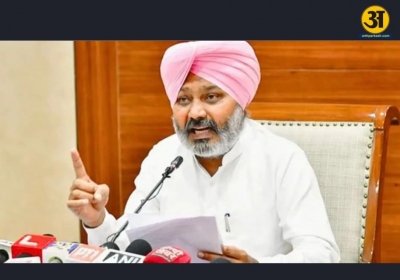.png)
World Bank's Global Economic Prospects Report, released on Tuesday
World Bank: India growing at 8.3%, global economy to decline sharply
According to the World Bank's Global Economic Prospects Report, released on Tuesday, global economic growth will fall sharply from 5.5 percent in 2021 to 4.1 percent in 2022 and 3.2 percent in 2023, while India's annual growth will be 8.3 percent in the current fiscal year, 8.7 percent in 2022-23, and 6.8 percent in 2023-24. The report also warned about the dangers of rising inequality and inflation.
Due to new Covid-19 versions, rising inflation, debt, and income inequality, the winding down of fiscal and monetary support, and the fading of pent-up demand, the global economy is headed for a "pronounced slowdown," which has eroded recovery prospects in emerging and developing economies in particular.
The report says, “The rapid spread of the Omicron variant indicates that the pandemic will likely continue to disrupt economic activity in the near term. In addition, a notable deceleration in major economies — including the United States and China — will weigh on external demand in emerging and developing economies. At a time when governments in many developing economies lack the policy space to support activity if needed, new Covid-19 outbreaks, persistent supply-chain bottlenecks and inflationary pressures, and elevated financial vulnerabilities in large swaths of the world could increase the risk of a hard landing,”
India, on the other hand, is a relatively bright spot in the South Asian picture. The Bank's forecast for India's growth in 2021-22 remains unchanged from its June forecast. However, the forecasts for 2022-23 and 2023-24 have been revised to 8.7% and 6.8%, respectively, "reflecting higher private sector and infrastructure investment, as well as dividends from ongoing reforms."
According to preliminary estimates from the country's statistics office, India's GDP would increase 9.2 percent this fiscal year, ensuring that the economy will surpass its pre-pandemic level (2019-20). In December, most high-frequency indicators were at or above pre-pandemic levels, while limits imposed by the Omicron-driven third wave of the coronavirus pandemic caused increased disruptions in January.
The World Bank report highlights several risks specific to South Asia: the emergence of Omicron could stifle economic activity by restricting mobility and lowering external demand; rising price pressures could cause inflation expectations to become unanchored, "worsening domestic financing conditions, eroding real incomes, and weakening the financial sector"; and the region remains vulnerable to climate-related increases in poverty, disease, and child mortality.
Inequality between and within countries, as well as inflation, will stymie recovery in both established and emerging economies.
The analysis predicts a considerable difference in growth prospects between advanced and emerging economies by 2023; output in emerging and developing nations will remain 4% below pre-pandemic levels.
The report further says, “The pandemic has raised global income inequality, partly reversing the decline that was achieved over the previous two decades. It has also increased inequality in many other spheres of human activity — in the availability of vaccines; in economic growth; in access to education and health care; and in the scale of job and income losses, which have been higher for women and low-skilled and informal workers. This trend has the potential to leave lasting scars: for example, losses to human capital caused by disruptions in education can spill over across generations.”
“Rising inflation – which hits low-income workers particularly hard – is constraining monetary policy. Globally and in advanced economies, inflation is running at the highest rates since 2008. In emerging market and developing economies, it has reached its highest rate since 2011. Many emerging and developing economies are withdrawing policy support to contain inflationary pressures – well before the recovery is complete,” it is further included.
On the subject of inflation, India is not unique. Retail inflation has been above 4% in recent months (it was 4.9 percent in November), with core inflation (excluding food and gasoline) continuing even higher at 5.9%. Wholesale inflation was also high in November, at 14.23 percent, owing to increases in food and fuel prices.





